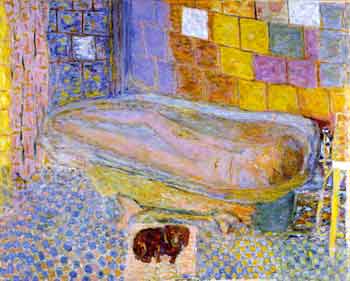Pierre Bonnard, 1867 – 1947.
Pierre Bonnard belonged to a group of painters who were known as The Nabis. The word nabi is Hebrew for prophet ‘inspired to speak the word of God’ The group worked together from 1900 to 1906, when they split up.
I have admired the work of the French painter Bonnard for many years, long before I learnt about the Nabis and their contemporaries. I would walk from our home south of the river, to visit the Tate Gallery and would gaze at The Bonnard painting he did of his wife Marthe in her bath. Pierre Bonnard is accessable as a painter, which is probably why I liked his work so much, but in fact these painters in the group were to influence Cubist painters who worked later. He borrowed lightness from the Impressionists, the bold colours of the Post Impressionists and the Fauves, he filled his work with his own intensity.The group was aware of Japanese prints, as were many painters at the time, such as Van Gogh, they also liked Art Nouveau, which was especially popular in Paris for a short time, until Art Deco arrived on the scene.
One of the group, Maurice Denis, worte that ‘the canvas is a flat surface covered with colours, assembled in a certain order’, while Eduard Vuillard wrote ‘who speaks of art speaks of poetry’. What concerned them was individuality, using pure colour organisation and form. Denis said he didn’t paint portraits, he painted people in their home. I understand the difference.
The Nabis explored the daily scene, using symbols we understand, not in the way the Impressionists had when they captured ephemeral light, but they looked back to traditional values, for a static and unchanging conception of reality. Their critics thought the work was a regressive form of painting, which ignored the achievements of the Impressionist painters. The Nabis rejected the painting theories of their tutors, which they considered to be materialistic, the Nabis aimed to use colour and design, to bring about harmony and balance – the goals of Classicism.
Bonnard spent his working life ‘exploring and analysing the process of seeing and looking and so translating ways in which visual perceptions interlock with the process of memory.’ Nicholas Serota.
To return to the painting of Marthe in the bath, the painting glows with yellow, the bath is a ‘porcelian tomb made incadescent by the gold and violet light, reflecting off the surfaces of the tiles and the water’. The use of complementry colours makes them zing, Matisse and Van Gogh, to name two painters, used the same technique.The subject matter in Bonnard’s work is I find, comforting, not sentimental though, their dog would often feature in his work, every day situations were captured, sitting in the garden drinking tea, laying a table for a meal, three generations painted in a triangular composition, grandmother,  mother and baby. His self portraits were different, searing and strong, to be compared favourbly with those of Van Gogh and Rembrandt. Bonnard would often mix up perspective, a table for example would be on a different plane, to show what lay on it more fully, he used geometry and perspective in order to obtain the effect he sought. I think he succeeds in integrating art and every day life.
mother and baby. His self portraits were different, searing and strong, to be compared favourbly with those of Van Gogh and Rembrandt. Bonnard would often mix up perspective, a table for example would be on a different plane, to show what lay on it more fully, he used geometry and perspective in order to obtain the effect he sought. I think he succeeds in integrating art and every day life.
